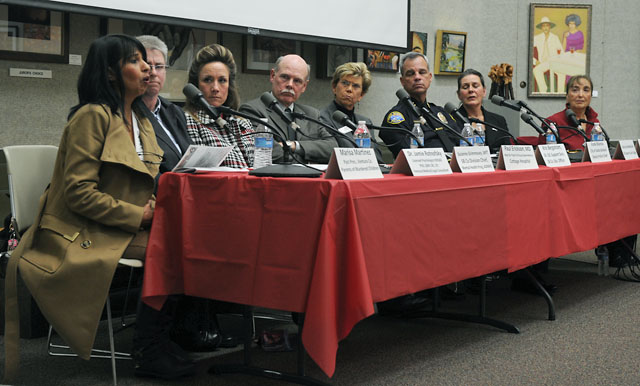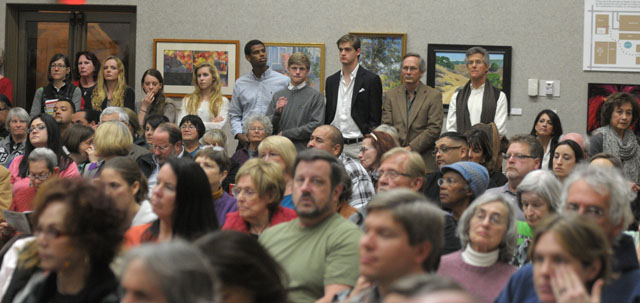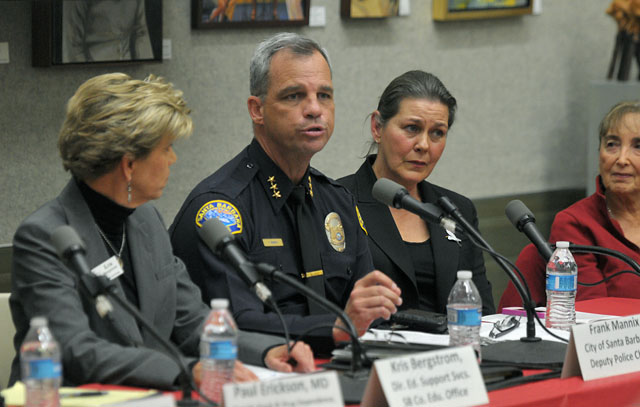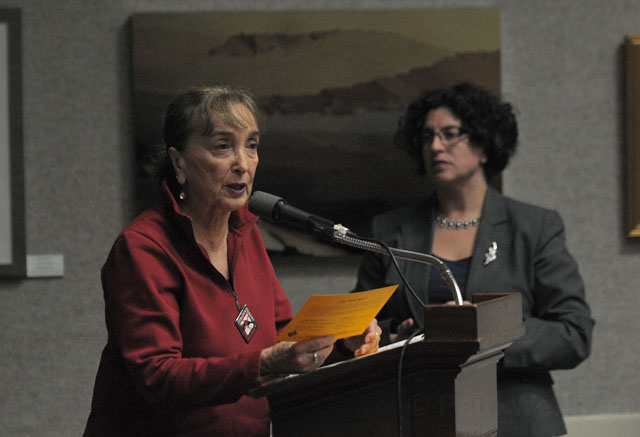Shoot-Shoot, Bang-Bang
Panel Explores Gun Violence in Santa Barbara

No wonder the room was packed. For the past 18 years, Santa Barbara’s Coalition Against Gun Violence has been preaching to the converted on the need for gun control. But last week’s forum organized by the coalition — held at the downtown library’s Faulkner Gallery — came two months after the Sandy Hook massacre in which 20 Connecticut school kids and six adults were mowed down in a blizzard of hot lead. And it came just two days after a 21-year-old Ventura resident was shot to death while riding a bike just half a block from the rear entrance to Santa Barbara High School. Witnesses reported hearing four shots fired on a very public street. By Santa Barbara standards, such a public display of gunfire is highly unusual. To date, no arrests have been made, and police investigators have yet to release the identity of the victim, itself also unusual.

Santa Barbara Mayor Helene Schneider moderated the panel discussion, which was notably devoid of any representatives of the “gun rights” point of view. Most of the speakers — who included a judge, a high ranking cop, the mother of a drive-by shooting victim, and a handful of mental health experts — agreed that easy access to copious quantities of guns and ammo coupled with America’s seemingly insatiable yen for violent entertainment has yielded grim results. By the year 2015, the death toll inflicted by guns will exceed that caused by automobile accidents, stated Toni Wellen, who has kept the coalition going since 1994. Roughly 32,000 Americans are killed a year by gun violence, she pointed out. By contrast, she noted, the Korean War claimed the lives of 33,686 American troops, and Vietnam took 58,193. America leads the world in gun ownership, she said, with 300 million guns. That’s 88 guns per 100 people. Coming in second is Yemen, with 55 guns per 100 citizens. “If guns made us safe,” Wellen said, “we’d be the safest country in the world.”
Judge Denise de Bellefeuille argued that the level of gun-inflicted carnage has achieved the “critical mass” sufficient for the public to seriously question the extent to which the right to bear arms has trumped public safety. In the meantime, DeBellefeuile said she would not join in the national celebration of violent entertainment. As a former prosecutor, DeBellefeuile said she saw more than enough blood and guts doing murder-suicide ride-alongs. “Don’t buy a ticket to Die Hard,” she advised the standing-room crowd.

Assistant Police Chief Frank Mannix argued the time to plan one’s response to a shoot-out scenario is now, not when the shoot-out occurs. People should run, hide, and be prepared to fight, he said. The police, he went on, will take about 10 minutes to show up and take charge. “During that time, quite frankly, you’re on your own,” Mannix stated. He noted that in the past 10 years, the City of Santa Barbara has experienced 375 gun-related crimes. In an interview after the forum, Mannix elaborated that of those 375 instances, five involved homicides of which one was a double homicide. Thirteen involved suicides. And 131 involved guns used in the course of a robbery. That statistic, Mannix cautioned, might convey an inflated sense of how often guns are used in Santa Barbara. He said the notes bank robbers give the tellers are counted as “gun crimes” whether guns are shown or not. That’s the most frequently occurring instance in which guns are used in the course of robberies, he said. In addition, Mannix noted that there were 76 instances of gun brandishing over the past 10 years. Brandishing, he said, is defined by displaying a gun in a “rude and intimidating” manner. Brandishing, he said, also includes the use of facsimile guns.

Mannix’s numbers underscore a point later made by Dr. Paul Erickson, head of Cottage Hospital’s mental health department. Massacres like Sandy Hook may get all the media attention, he noted, but they don’t do the most damage. That distinction, he said, goes to suicides by gun, which he noted outnumber homicides by a two-to-one margin. Since Sandy Hook, there’s been considerable focus on the flaws of the mental health systems. Erickson said he welcomed the recent onslaught of mental health advocates but that the discussion has been clouded by several myths. He noted that only 4 percent of people who commit gun violence have been clinically diagnosed with a mental illness. He acknowledged that many of the young men involved in the high profile mass shootings have been mentally ill. Few of these, he said, have sought treatment. And, he added, “The leverage to require treatment is very limited.” To place people in an involuntary hold in California, for example, requires a finding that they pose a threat to themselves or to others. And that hold — known as a 5150—expires after 72 hours.
Adding a broader sociological perspective, Dr. Jamie Rotnofsky noted that gun violence correlates highly with poverty and ethnicity. Young black men in Philadelphia have a higher chance of being killed by gunfire, she noted, than if they served in the armed forces in Afghanistan. Packing the most emotional punch was Marisa Martinez of Oxnard, whose 19-year-old son Vince was shot to death in front of his house eight years ago. His last words, Martinez said, were, “I don’t want to die, Mom; don’t let me go.” Martinez, who has been crusading against gun violence ever since, said the event still inflicts damage on the family. Vince’s twin brother, she said, doesn’t get out of bed and is on numerous medications to treat post-traumatic stress. “I feel I lost two sons,” she said. Every month, she said, the family gets a check for $6, compensation administered by the state from her son’s killer, now in a state prison. “The person who killed my son had 11 guns in their house,” she said. “How could the family not know there were 11 guns in the house. I sure would know.”


